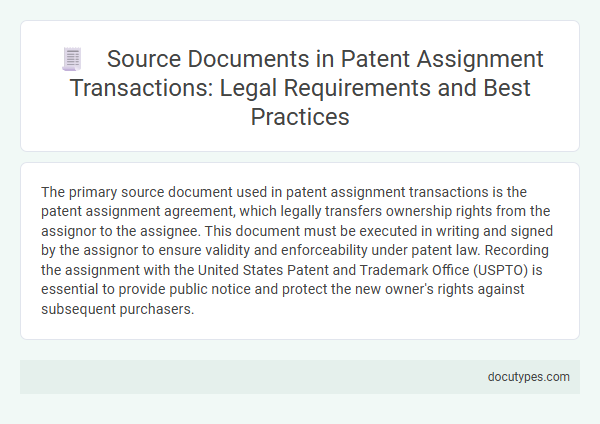The primary source document used in patent assignment transactions is the patent assignment agreement, which legally transfers ownership rights from the assignor to the assignee. This document must be executed in writing and signed by the assignor to ensure validity and enforceability under patent law. Recording the assignment with the United States Patent and Trademark Office (USPTO) is essential to provide public notice and protect the new owner's rights against subsequent purchasers.
Introduction to Source Documents in Patent Assignment Transactions
Source documents play a crucial role in patent assignment transactions by providing the legal foundation for transferring patent rights. Understanding these documents ensures clarity in ownership and helps protect intellectual property effectively.
- Patent Assignment Agreement - This is the primary document outlining the terms and conditions under which patent rights are transferred from the assignor to the assignee.
- Recordation Forms - Required by the United States Patent and Trademark Office (USPTO), these forms officially document the transfer and update the patent ownership records.
- Supporting Documentation - Includes any additional contracts, correspondence, or evidence that supports the validity and execution of the patent assignment.
Legal Framework Governing Patent Assignment Documentation
Patent assignment transactions rely on specific source documents to legally transfer ownership rights. The legal framework governing these documents ensures proper validation and enforceability of patent transfers under applicable intellectual property laws.
- Assignment Agreement - This primary document records the contractual transfer of patent rights from assignor to assignee.
- Patent Assignment Form - A standardized form submitted to the patent office to formally record the assignment in public records.
- Legal Requirements - Compliance with statutory provisions and formalities, including signatures and notarization, validates the assignment process.
Essential Types of Source Documents in Patent Assignments
Patent assignment transactions primarily rely on a written agreement known as the Patent Assignment Agreement. This document outlines the transfer of ownership rights from the assignor to the assignee, ensuring legal clarity and enforceability.
Other essential source documents include the original patent certificate and formal assignment records filed with the United States Patent and Trademark Office (USPTO). These documents serve as proof of ownership transfer and are crucial for maintaining accurate patent title history.
Core Legal Requirements for Valid Patent Assignment Documents
Patent assignment transactions rely on a written document known as the patent assignment agreement, which legally transfers ownership of the patent rights from the assignor to the assignee. This source document must clearly identify the parties involved, describe the patent being assigned, and state the intent to transfer rights.
Core legal requirements for valid patent assignment documents include a signed writing to satisfy the Statute of Frauds, ensuring enforceability in court. The assignment must be recorded with the United States Patent and Trademark Office to provide public notice and protect the assignee's rights against third parties.
Key Clauses and Elements in Patent Assignment Agreements
In patent assignment transactions, the primary source document used is the Patent Assignment Agreement. This agreement legally transfers ownership rights of a patent from one party to another.
Key clauses in patent assignment agreements include the identification of the parties involved, a clear description of the patent being assigned, and the assignment of rights and title. The agreement also contains representations and warranties to ensure the validity of the patent and the authority to assign it. You must review these elements carefully to protect your interests in the transaction.
Notarization and Witnessing: Formalities for Patent Assignment Documents
Patent assignment transactions require specific source documents to legally transfer rights from the assignor to the assignee. Notarization is often necessary to authenticate the signatures, ensuring the document's validity in legal proceedings. Witnessing formalities further reinforce the assignment by providing third-party verification, which safeguards Your patent rights and helps prevent future disputes.
Electronic Signatures and Digital Records in Patent Transfers
In patent assignment transactions, the source document commonly used is the assignment agreement, which legally transfers ownership rights from the assignor to the assignee. Electronic signatures on these agreements are legally recognized under laws such as the ESIGN Act and UETA, ensuring validity and enforceability in patent transfers. Digital records of patent assignments are maintained in electronic databases, such as the USPTO's Electronic Patent Assignment System, providing secure and accessible documentation for ownership changes.
Best Practices for Drafting and Maintaining Patent Assignment Documents
| Source Document | Patent Assignment Deed or Agreement |
|---|---|
| Definition | A legal document that transfers ownership rights of a patent from the assignor to the assignee. |
| Key Components |
|
| Best Practices for Drafting |
|
| Maintaining Patent Assignment Documents |
|
Common Pitfalls and Legal Risks in Source Documentation
In patent assignment transactions, the source document primarily used is the patent assignment agreement, which legally transfers ownership rights. Accurate and thorough source documentation is crucial to avoid disputes and ensure clear title transfer.
- Ambiguous Language - Vague or unclear terms in assignment documents can create legal uncertainties regarding the scope of the rights transferred.
- Lack of Proper Execution - Failure to properly execute and notarize the assignment can result in unenforceability in certain jurisdictions.
- Inadequate Description of Patents - Omitting accurate patent numbers or titles may lead to incomplete or invalid transfers of rights.
Thorough review and precise drafting of patent assignment source documents minimize legal risks and help secure enforceable ownership rights.
Which Source Document Is Used in Patent Assignment Transactions? Infographic

